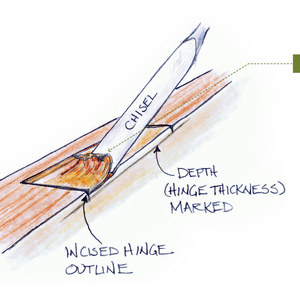Google hasn’t helped me with this one. I have a county form that shows the following types of drainfields: standard, trench, filled, bed, mound. Having a hard time figuring all the differences. How is filled or bed different from mound? And how is bed diff than standard?
Discussion Forum
Discussion Forum
Up Next
Video Shorts
Featured Story

Listeners write in about shower panels and cordless tools and ask questions about old wiring, air leaks, and gutter covers.
Featured Video
Video: Build a Fireplace, Brick by BrickHighlights
"I have learned so much thanks to the searchable articles on the FHB website. I can confidently say that I expect to be a life-long subscriber." - M.K.
Fine Homebuilding Magazine
- Home Group
- Antique Trader
- Arts & Crafts Homes
- Bank Note Reporter
- Cabin Life
- Cuisine at Home
- Fine Gardening
- Fine Woodworking
- Green Building Advisor
- Garden Gate
- Horticulture
- Keep Craft Alive
- Log Home Living
- Military Trader/Vehicles
- Numismatic News
- Numismaster
- Old Cars Weekly
- Old House Journal
- Period Homes
- Popular Woodworking
- Script
- ShopNotes
- Sports Collectors Digest
- Threads
- Timber Home Living
- Traditional Building
- Woodsmith
- World Coin News
- Writer's Digest



















Replies
I got alot of help from a civil engineer in my neck of the woods, who ultimately did the design work as part of a request for a zoning variance. Counties can be pretty picky about percolation tests, distance between grade and bedrock, etc., and it's those things that quite often dictate what kind of drainfield/septic system you'll need.
Are you getting a permit to construct a drainfield, just filling in the form, or just curious? I'll post some links to information I found last year.
This one is pretty good, but somewhat limited:
http://www.extension.umn.edu/distribution/naturalresources/DD6583.html
Edited 9/10/2003 2:32:51 PM ET by johnnyd
Here's a bit more. Might be helpful. I've got a book on this all but that would be kinda hard to post. :-)
Gotta run for now. Lunch has been briskly swallered.
http://www.metrokc.gov/health/wastewater/types.htm
Oooops. Meant for CH.
Knowledge is power, but only if applied in a timely fashion.
Edited 9/10/2003 4:40:51 PM ET by GOLDHILLER
Jim: They differ mainly in cross-section i.e. the shape of the interface between highly permeably fill and lower permeability native soils. The worse the results of a perc test, the larger an area the interface needs to be.
The other driver is the depth of the water table. With very shallow water, you end up having to do a mound system where all the percolation AND treatment occurs in the mound. That is a mess of dirt!
So you need 1) enough surface area to perc the design flow rate and 2) enough unsaturated soil to allow microbes to breakdown the effluent from the septic tank. Getting that 1) surface area and 2) volume is why different geometries are used in different soil types and with different water table depths.
I'll try to look up all those terms when I get home. My own house is on such clean sand (below the brown dirt) that the perc test dictate only 21 feet of leach field. At an 11-foot depth for freeze-protect reasons, but otherwise a very easy area for leach fields.
I just had to do the research on this myself and I will share with you. But no one else, so, keep this to yourself, OK?
All Septic System Information Website
Columbia Homeownerrs Guide to Lagoons
Household Wastewater Management
Lagoon Design & Operation
NSFC Onsite Wastewater Regulatory Agencies by State
Onsite Edition 13
Residential On-site Wastewater Treatment Lagoon Design and Construction
If you want, I can send you my entire "septics" library. It zips to only 8MB. ;>)
SamT
I'd been to a lot of these sites, but they don't use some of the same terms as the form. It's a FL form for a client and he has a permit for "filled" and "bed" but not the others. So I'm trying to learn more about the distinctions. I only design w/in the building envelope with just a waste pipe out of the house, but I still do want to learn about this other stuff.
Have had some experience with septics, for what it is worth this is what I know. Standard and trench to me are the same thing, generally 3' trench (width) depth is usually determined by the county sanitarian or civil eng., which usually occurs with perk test. All fields size and type are determined by soil conditions and number of bedrooms.
Filled indicates to me that material is excavated out and a washed course sand (2ns) my geo. area is installed, again depth of cut is then determined by civil eng. or sanitarian.
Bed is usually area excavated with stone and or sand thru -out as opposed to trench system, in some instances I have done a 50% percent cut down which is half of area excavated to 8-10' and filled with sand and then stone .
Mound can be a combination of the ones mentioned above,(exception trench) with area contain by clay berms to prevent leaching from sides. Mounds are generally 2-4' above existing grade., always depending upon civil eng. or sanitarian requirements.
Sand filter systems are the new thing where soils will not perk, fairly extensive and pricey, but doable,Oregon Florida
Look at http://www.orenco.com, they have a lot of residential systems, I run a wastewater treatment plant, we use their products, good reliable equipment.
usual disclaimers apply
Alan